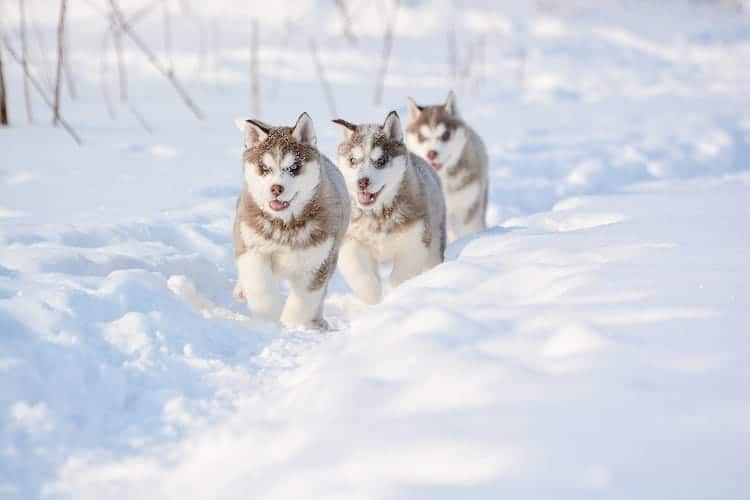
For humans and their furry babies, those daily walks may be getting more uncomfortable as the days go by because, you know—winter is coming. If it’s getting too cold for you, maybe it’s getting too cold for your dog also. But a little snow on the ground shouldn’t keep you and the furry kid from taking walks. After all, there’s nothing like a bracing and invigorating walk during a cold day to chase those winter blues away. Giving a nice, warm jacket to your dog as extra protection from the cold would likely earn you a few slobbery kisses.
Not All Breeds Are The Same
If you have one of those giant northern breeds, like a Siberian Husky, a Newfoundland, or an Alaskan Malamute, they probably wouldn’t need extra protection. They already have their own thick, dense coats. These breeds are well-suited to dance and gambol in the snow.
Many canine friends may be born to play in the snow, but some breeds should wear a jacket during their winter walks. Some would need not only extra layers but little booties, too, like the ones at Canada Pooch. Keep the following tips in mind when deciding whether your furry friend may need additional protection from the cold:
- Dogs that are certain to be needing additional layers during the cold weather are the toy and small breeds like the Mini Pinschers, Toy Poodles, Pugs, Dachshunds, Chihuahuas, Italian Greyhounds, Chinese Crested, and others.
- Small dogs need extra layers because of the cold and because their bellies would touch the mounds of snow and ice. Not only small dogs but dogs with short legs, too—like those clowns of the dog world, those sneaky and stubborn but extra affectionate Basset Hounds.
- Giant breeds like Malamutes and Newfies do not typically need jackets, but other similarly-sized dogs have short hair coats that offer no protection against the cold weather. For example, the gentle giants Great Danes, Greyhounds, and the often-misunderstood Pit Bulls would undoubtedly be needing extra layers, too.
Also, remember to watch your dog’s body language. When dogs get cold, they may sometimes hold up their paws or shiver, or refuse to walk. If your furry kid shows any of these behaviors, it’s time to bust out that coat and bundle them up. Or better yet, take them inside.
Things To Consider Before Putting Extra Layers On Your Dog
There are several things to consider whether your dog needs a jacket before going out. Is it threatening to rain? Is wind chill going to be a factor? Is the sun shining? As a rule of thumb, always err on the side of caution. You can always take your dog’s winter gear if it gets too warm. And always, always, watch for any signs of distress or discomfort. If they’re showing any tell-tale signs like shivering, limping, or slowing down, it’s time to pack it in and go somewhere warm.
Consider also your dog’s age, their health condition, and their acclimation to the cold weather. Healthy, adult dogs are content to play and run around even when it is cold. But not puppies and elderly dogs. They would have difficulties staying warm. Keep in mind that even though dogs have fur, they can’t always tolerate the cold. Dogs are used to the warmth of a home, and the cold can be as hard to them as it is to humans. They need extra care during the winter.
Choosing The Right Winter Gear For You Furry Kid
First, you’d want to ask your vet whether your dog needs extra layers. After getting approval from your vet, you’ll have to choose the type of winter gear your furry kid needs. Decide what type of material is best. Will it be compatible with your dog’s coat? Better ask the vet for any recommendations. Certain fabrics may cause an allergic reaction from your dog, like itching, swelling around the face, sneezing, hives, and red and inflamed skin.
Make sure also that your dog’s cold-weather gear fits them well. You’ll have to take their measurements because you don’t want their clothes too tight or too loose. A too-tight jacket could restrict their movement, while a too-loose coat could fall off them.
Depending on hair lengths, dogs like Shih Tzus may only need a sweater. Hairless breed like the Chinese Crested would require a heavy jacket. If you and your pooch plan to stay out for longer periods, water-proofed jackets are recommended, with lightweight insulation for warmth. Jackets that are too bulky could impede your dog’s walking. Avoid also clothing with buckles, decorative pieces, or buttons. Your dog might eat them. And get a coat that is easy to put on and take off.
Keep Your Dog Safe
During cold weather, shorten your walks to avoid frostbite. Below-freezing temperature is frostbite territory, not just for humans but for dogs, too. There’s always a danger of being frostbitten, even with a jacket. The parts of a dog susceptible to frostbites are the ears, paws, and tail—areas not protected by clothing.
Watch out too for signs of overheating: panting, high temperature, red gums, and drooling. Contact your vet immediately if you see these symptoms. Your dog might be suffering from heatstroke. Never leave your dog outside during extreme temperatures. And if they’re wearing a jacket, avoid letting them out of your sight.
Don’t forget to look into doggie booties. Your dog might need them if you’ll be walking during extreme weather. A good pair of booties can protect your dog’s sensitive paw pads from the snow and ice when you two go traipsing about in the cold. Of course, that’s assuming you and your dog both like to go out to explore the neighborhood and nearby parks.
